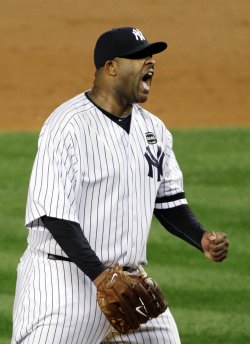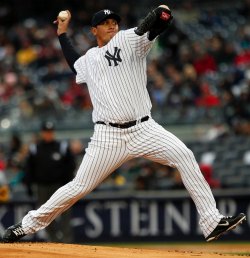So far, in examining the Yankees offense, we’ve learned that the infield is pretty good and that the outfield is phenomenal. It all adds up to the second-best offense in the league (though the most high-powered one). Yet it’s the pitching staff that has impressed the most this year. Thought to be one of the team’s weak points heading into the season, the pitchers have stepped up and have allowed just 3.80 runs per game, which ranks fourth in the AL. Let’s see how the starters stack up.
Comparing pitchers is a bit trickier than comparing hitters. Defense consists of two aspects: pitching and fielding. Both have an effect on run-scoring, and so when I say that the Yankees pitchers’ have held opponents to 3.80 runs per game, I really mean that the Yankees pitchers and fielders have done that. Sticking with the three-point comparisons, we’ll go with ERA, which includes both pitching and fielding, FIP, which isolates pitcher-specific events, and WAR.
NOTE: There are 113 qualified pitchers.
CC Sabathia

Coming into the season, Sabathia was the one pitcher on whom the Yankees could rely. With only Phil Hughes and A.J. Burnett as surefire rotation candidates behind him, the Yankees needed Sabathia to step up and again be the ace they signed to the most expensive contract for a pitcher in MLB history. He’s done that and more, turning in a superb first half.
ERA: 2.72, 14th. In years prior, a 2.72 ERA would certainly rank higher than 14th in the majors. But in this reduced run-scoring environment it’s a degree lower. Still, plenty of teams don’t have a player with an ERA nearly this low. It’s a great mark, even if it’s not top-10 in teh league.
FIP: 2.50, 5th. Now we’re talking. Thanks to a low walk rate and an even lower home run rate, Sabathia’s fielding-independent stats rank far higher than most of his peers. His strikeout rate has been rising, too, especially in his last few starts.
WAR: 4.8, 2nd. This is what happens when you have the second most innings pitched in baseball. Sabathia provides major value this way. He not only pitches quality innings, but he pitches a lot of them. There aren’t many workhorses left, and that’s one reason that Sabathia is the richest pitcher in baseball.
Bartolo Colon

Who would have thought that Colon would even make the team out of spring training, never mind turn into their second best pitcher? Bart has been a pleasant surprise of the greatest kind. Not only has he been effective in the first half, but he’s been a joy to watch. That two-seamer is a thing of beauty, and we can only hope beyond hope that he remains healthy in the second half.
ERA: 3.20, 35th. Big Bart has done a great job keeping runs off the board in his 90 innings. His season is so far bookended by two tough appearances, meaning all the appearances in between were that much better. He certainly does take advantage of the defense, though he does have a decent strikeout rate.
FIP: 3.54, 42nd. Colon’s success might seem like luck, in large part, but he’s actually pitched well in fielding-independent terms. This is because he doens’t walk many batters, a 2.20 BB/9. That, combined with a slightly below average BABIP, means he has fewer runners on base when he allows home runs — he’s given up 11 in 90 innings. This does give some hope for the second half.
WAR: 1.6, 50th. Such are the perils of starting the year in the pen and then spending a few weeks on the DL. Colon would be higher if he had pitched more than 90 innings, but hey, he’s got fewer innings pitched than the other pitchers who are around the 1.6 WAR mark. Again, it bodes well for the second half — if he stays healthy.
A.J. Burnett

This is a big year for Burnett. He slid considerably in 2010, and the Yankees needed him to step up in a rebound effort. If he didn’t, who knows what they’d have to do. It’s not easy to deal with a guy who has that much money remaining on his contract. He’s been decent, at best, but it could obviously be a lot worse. It’s not acceptable really, but it’s reality at this point.
ERA: 4.15, 77th. Honestly, this could be a lot worse. It’s certainly below average, but it’s not nearly as bad as last year. The main difference is that he’s so far avoided his June, 2010-like implosion month. His strikeout rate is acceptable and his walk rate is predictably high, but Burnett has managed to get the job done.
FIP: 4.54, 96th. What happens when you give up a lot of homers and walk too many batters? Usually it will lead to an inflated ERA, but in the case of Burnett it has only inflated his fielding-independent stats. A .242 BABIP helps keep men off base, thus reducing the effect of the homers. I just fear that the magic wears off in the second half. On the other hand, xFIP, which normalizes home run rate based on fly balls allowed, has Burnett several degrees better, at a 3.85 mark.
WAR: 0.9, 83rd. Burnett has pitched 119.1 innings, so that’s not the issue with his WAR. Rather, it’s his 4.54 FIP. It would be a shame to see the Yankees get less than two wins over replacement for their $17.5 million, but that was the risk with Burnett. Of course, the original risk was that he’d get hurt and not pitch enough innings to eclipse 2 WAR. I don’t think anyone figured him to pitch this poorly.
Freddy Garcia

Garcia hasn’t been a surprise on the level of Colon, in that he doesn’t dazzle with his stuff. But he has been far more effective than anyone could have wished. When the Yankees signed him to a minor league deal it made sense, since they had recently heard of Andy Pettitte’s retirement. At that point I thought he’d fill in for a month or two and then be back on the scrap heap. But he’s been a big part of the rotation’s success so far.
ERA: 3.13, 32nd. This is the biggest surprise of all. Who would have thought that Garcia would have the second-lowest ERA on the team through the first half? I’m guessing it’s only slightly larger than the number of people who thought he’d be here, period. Garcia has used smoke and mirrors to work his way through lineups, but hey, the Yanks will take it at this point.
FIP: 3.97, 72nd. While Colon has put up solid fielding independent numbers, Garcia has been a bit less than that. Again, it’s to be expected. He’s kept the ball in the park despite a low ground ball rate, but he has an embarrassingly low strikeout rate. Still, even if he regresses to his FIP in the second half, he’ll still be only slightly below average. Again, I’m pretty sure everyone would have taken that from Freddy when he signed this winter.
WAR: 1.3, 71st. As with Colon, this is largely a product of innings, just 92. Since FanGraphs WAR is based on FIP, Garcia gets dinged a bit here. Again, the idea is not to show what should have happened. Rather, it’s to give the pitcher credit for only things that he, and not the defense, did.
The Yankees have also gotten 22 starts out of Ivan Nova, Brian Gordon, and Phil Hughes. While I’d love to put them into the comparison, Nova is in AAA and the other two have combined for 25.2 innings. Nova would rank just ahead of Burnett in the ERA and FIP categories while falling 0.1 WAR behind (on account of innings pitched). Overall it’s hard to argue with the effectiveness of the starting staff. It might not be pretty, but they’ve gotten the job done.
Leave a Reply
You must be logged in to post a comment.